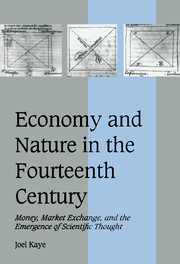 Economy and Nature in the Fourteenth Century
Economy and Nature in the Fourteenth Century Book contents
- Frontmatter
- Contents
- Acknowledgments
- INTRODUCTION
- 1 THE ECONOMIC BACKGROUND: MONETIZATION AND MONETARY CONSCIOUSNESS IN THE THIRTEENTH AND FOURTEENTH CENTURIES
- 2 THE ARISTOTELIAN MODEL OF MONEY AND ECONOMIC EXCHANGE
- 3 THE EARLIEST LATIN COMMENTARIES ON THE ARISTOTELIAN MODEL OF ECONOMIC EXCHANGE: ALBERTUS MAGNUS AND THOMAS AQUINAS
- 4 MODELS OF ECONOMIC EQUALITY AND EQUALIZATION IN THE THIRTEENTH CENTURY
- 5 EVOLVING MODELS OF MONEY AND MARKET EXCHANGE IN THE LATE THIRTEENTH AND FOURTEENTH CENTURIES
- 6 LINKING THE SCHOLASTIC MODEL OF MONEY AS MEASURE TO PROTO-SCIENTIFIC INNOVATIONS IN FOURTEENTH-CENTURY NATURAL PHILOSOPHY
- 7 LINKING SCHOLASTIC MODELS OF MONETIZED EXCHANGE TO INNOVATIONS IN FOURTEENTH-CENTURY MATHEMATICS AND NATURAL PHILOSOPHY
- Bibliography
- Index
- Cambridge Studies in Medieval Life and Thought Fourth series
5 - EVOLVING MODELS OF MONEY AND MARKET EXCHANGE IN THE LATE THIRTEENTH AND FOURTEENTH CENTURIES
Published online by Cambridge University Press: 16 July 2009
- Frontmatter
- Contents
- Acknowledgments
- INTRODUCTION
- 1 THE ECONOMIC BACKGROUND: MONETIZATION AND MONETARY CONSCIOUSNESS IN THE THIRTEENTH AND FOURTEENTH CENTURIES
- 2 THE ARISTOTELIAN MODEL OF MONEY AND ECONOMIC EXCHANGE
- 3 THE EARLIEST LATIN COMMENTARIES ON THE ARISTOTELIAN MODEL OF ECONOMIC EXCHANGE: ALBERTUS MAGNUS AND THOMAS AQUINAS
- 4 MODELS OF ECONOMIC EQUALITY AND EQUALIZATION IN THE THIRTEENTH CENTURY
- 5 EVOLVING MODELS OF MONEY AND MARKET EXCHANGE IN THE LATE THIRTEENTH AND FOURTEENTH CENTURIES
- 6 LINKING THE SCHOLASTIC MODEL OF MONEY AS MEASURE TO PROTO-SCIENTIFIC INNOVATIONS IN FOURTEENTH-CENTURY NATURAL PHILOSOPHY
- 7 LINKING SCHOLASTIC MODELS OF MONETIZED EXCHANGE TO INNOVATIONS IN FOURTEENTH-CENTURY MATHEMATICS AND NATURAL PHILOSOPHY
- Bibliography
- Index
- Cambridge Studies in Medieval Life and Thought Fourth series
Summary
The scholastic analysis of money, exchange, and market value, already well underway in the thirteenth century, continued to evolve over the fourteenth century, with the commentaries on Aristotle's Ethics and Politics providing the most important loci for this discussion. In this chapter I discuss the advances made within each of the six categories of connection between scholastic economic thought and proto-scientific speculation. I remind the reader that these categories are heuristic constructs. My use of them to isolate the core insights underlying the scholastic model of economic exchange should not obscure the consistent, even necessary connections between these insights in the writings considered in this chapter. Dynamic equilibrium, relativity, the measuring continuum, and common valuation all work together within the new social geometry of the fourteenth century.
EQUALITY, THE MEAN, AND EQUALIZATION IN EXCHANGE
Through the fourteenth century, the controlling principle in economic thought remained equality. Without exception, thinkers defined economic exchange as a process of equalization. In the restricted case of the loan or mutuum, ideal equality continued to be determined in most cases arithmetically – the sum lent determined the sum that could be required in return, with no allowance for proportionality. However, in the broader realm of economic exchange that included buying (emptio) and selling (venditio), traditional requirements for arithmetical equality came under increasing challenge. Thinkers began to question the knowability and even the existence of definable points of exchange equality.
- Type
- Chapter
- Information
- Economy and Nature in the Fourteenth CenturyMoney, Market Exchange, and the Emergence of Scientific Thought, pp. 116 - 162Publisher: Cambridge University PressPrint publication year: 1998
